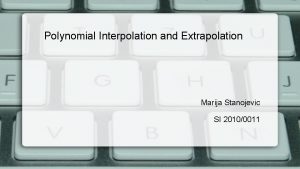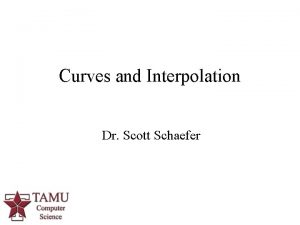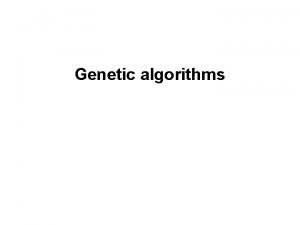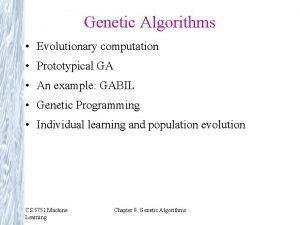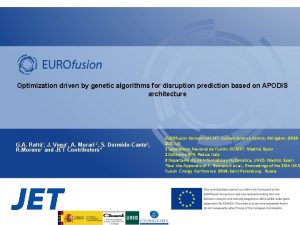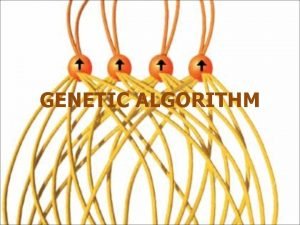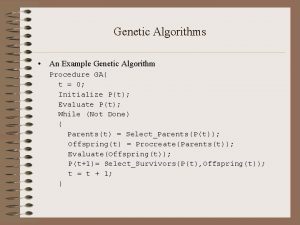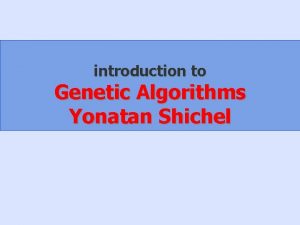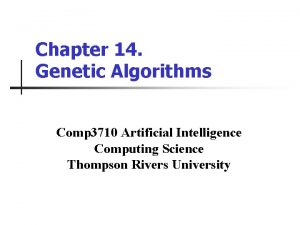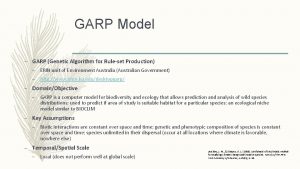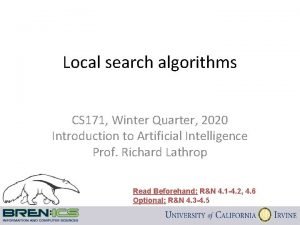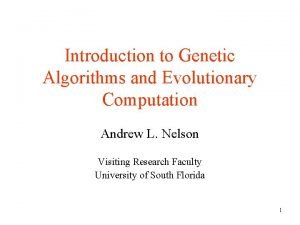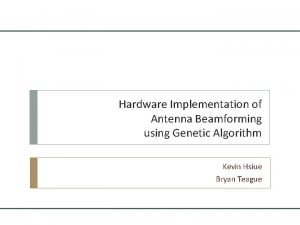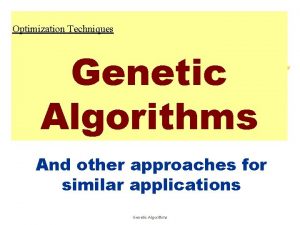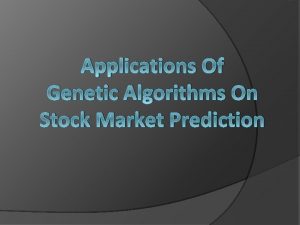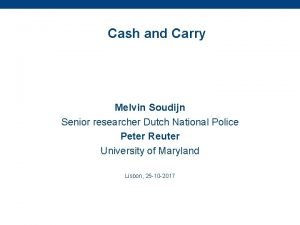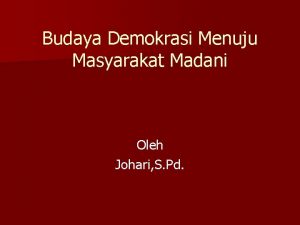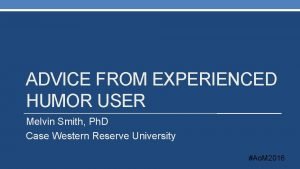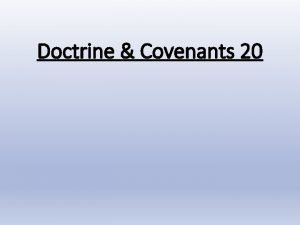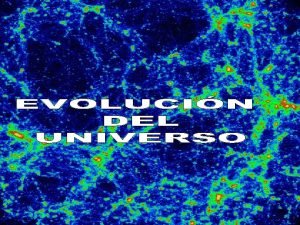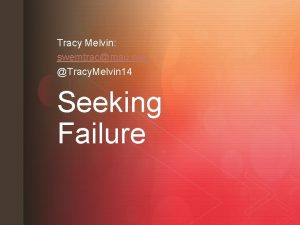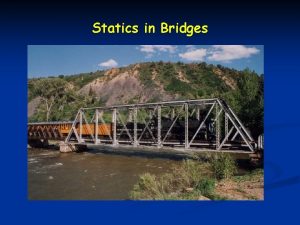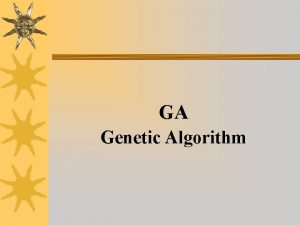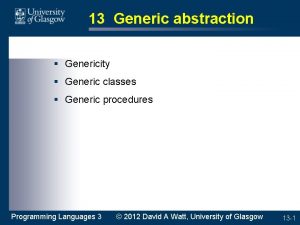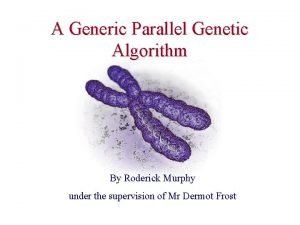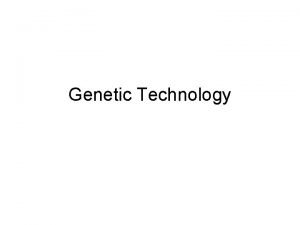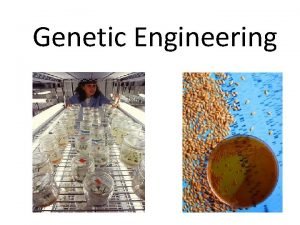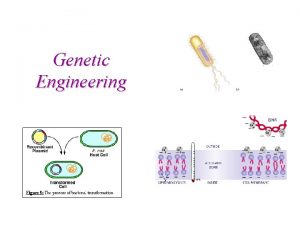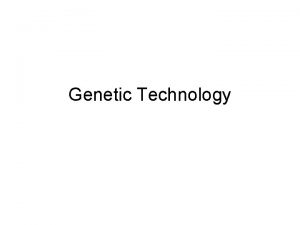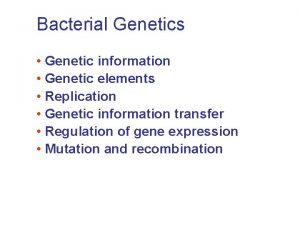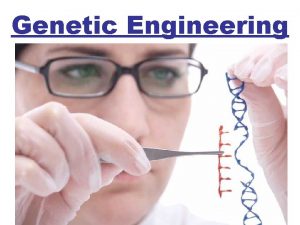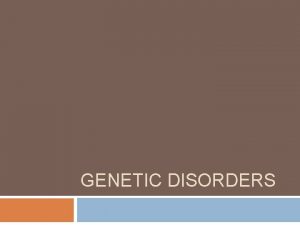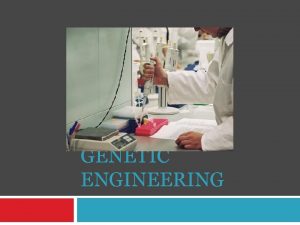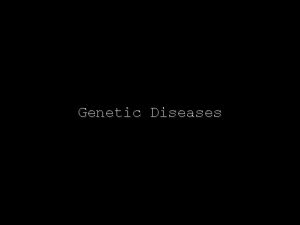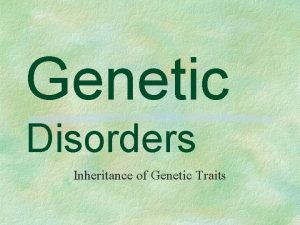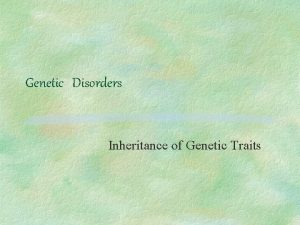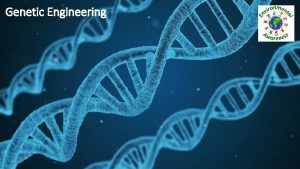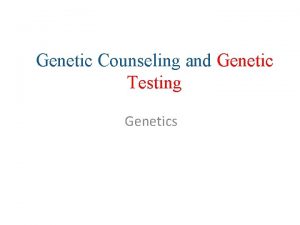Developing a Generic Genetic Algorithm Melvin Neville Anaika






































- Slides: 38

Developing a Generic Genetic Algorithm Melvin Neville & Anaika Sibley Northern Arizona University Flagstaff, AZ 86011 9/25/2020 Neville & Sibley: SIGAda Houston 1

Introduction n Melvin Neville, CSE faculty – Artificial Life • Evolution of intelligence • Biological neural net modeling n Anaika Sibley, CSE student – ASCI-PALS research (DOE) 9/25/2020 Neville & Sibley: SIGAda Houston 2

Introduction n CSE 470: Introduction to Intelligent Systems – Neural Nets, Fuzzy Logic, Genetic Algorithms – Building tools 9/25/2020 Neville & Sibley: SIGAda Houston 3

Outline n Introduction: Who we are and context n Genetic and Evolutionary Algorithms – Biological analogies – Genetic vs Evolutionary Algorithms – Our version – Sine function model n Conclusions: 9/25/2020 algorithm, teaching, Ada Neville & Sibley: SIGAda Houston 4

Genetic and Evolutionary Algorithms: Biological Analogies n Biological inspiration: evolution and Mendelian genetics n Gene and Allele – Parameter variations n Chromosome – Linkage among parameters n Mutation – Allele alterations n Crossover – evading local minima 9/25/2020 Neville & Sibley: SIGAda Houston 5

Biological Analogies n Biological inspiration: evolution and Mendelian genetics n Evolution: – Selection and “fitness” – Role of chance? – Problem of local minima (maxima) 9/25/2020 Neville & Sibley: SIGAda Houston 6

Biological Analogies Chromosomes and Genes 9/25/2020 Neville & Sibley: SIGAda Houston 7

Biological Analogies and Crossover 9/25/2020 Neville & Sibley: SIGAda Houston 8

Biological Analogies n Evolutionary Paradigm: The cycle – Selection among variants – “More fit”: Better chance to survive to reproduce – Their alleles more represented – Mutation and crossover increase variation 9/25/2020 Neville & Sibley: SIGAda Houston 9

Genetic vs Evolutionary Algorithms n Major distinctions per Michalewicz – Representation: • GA: Bit vector • ES: Floating-point vector – Selection: • GA: Repetitive random selection with fitness influence • ES: Fitness function without replacement 9/25/2020 Neville & Sibley: SIGAda Houston 10

Genetic vs Evolutionary Algorithms n Major distinctions per Michalewicz (cont. ) – Timing of mutation and crossover: • GA: After next generation selected • ES: Before next generation selected – Probabilities of mutation and crossover: • GA: Constant • ES: Can alter from generation to generation 9/25/2020 Neville & Sibley: SIGAda Houston 11

Genetic vs Evolutionary Algorithms n Major distinctions per Michalewicz (cont. ) – Handling “illegal” offspring: • GA: Penalize re fitness • ES: Discard or Impossible 9/25/2020 Neville & Sibley: SIGAda Houston 12

Our Version n Our algorithm: – 1. Initialize the generation counter to 0 – 2. Initialize the population of entities – 3. Iterate through generations until some stopping criterion met 9/25/2020 Neville & Sibley: SIGAda Houston 13

Our Version n Our algorithm: – 3. Iterate through generations • • • 9/25/2020 3. 1 Increment generation counter 3. 2 Each “winner” produces same # children 3. 3 Each child subject to chance mutation 3. 4 Each child has chance of crossover 3. 5 The children are evaluated 3. 6 The most fit are selected for the next generation (“winners”) Neville & Sibley: SIGAda Houston 14

Our Version n Our – – – parameters and data structures: Num. Win Child. Per. Winners list Children list Priority. Queue 9/25/2020 Neville & Sibley: SIGAda Houston 15

Our Version n Our parameters and data structures: mutate (3. 3) (2) init Winners list cross eval (3. 4) (3. 5) Children list (3. 2) create children to next generation (3. 6) select Priority Queue 9/25/2020 Neville & Sibley: SIGAda Houston 16

The Sine Function Model n Taylor’s series: f(y+h) = h 0 f(y)/0! + h 1 f’(y)/1! + h 2 f’’(y)/2! + h 3 f’’’(y)/3! + h 4 f’’’’(y)/4! + … n Sine series: sin x = x 1/1! – x 3/3! + x 5/5! – x 7/7! + … 9/25/2020 Neville & Sibley: SIGAda Houston 17

The Sine Function Model n Problem: to “evolve” the coefficients of the Sine Series n Subproblems: – Initial coefficient values? – Evaluation of “fitness”? – Interpretation of mutation? – Interpretation of crossover? 9/25/2020 Neville & Sibley: SIGAda Houston 18

The Sine Function Model n Initial coefficient values? – Set to zero (they go in both directions) 9/25/2020 Neville & Sibley: SIGAda Houston 19

The Sine Function Model n Evaluation of fitness? – Formula: Coefficients evaluated every N (5) degrees range 0. . 90 degrees: sum square divergences from math library sin() – Evaluation with initial coefficients of 0. 0: 9. 5000 9/25/2020 Neville & Sibley: SIGAda Houston 20

The Sine Function Model n Evaluation of fitness? – Evaluation with “perfect” coefficients: 0. 0000 – The “perfect” Coefficients (power of x): 0 => 0. 0000000 4 => 0. 0000000 1 => 1. 0000000 5 => 0. 0083333 2 => 0. 0000000 6 => 0. 0000000 3 => -0. 1666667 7 => -0. 0001984 9/25/2020 Neville & Sibley: SIGAda Houston 21

The Sine Function Model n Interpretation of mutation? – 0. . multiple genes can be selected – Alteration in coefficients by +/- delta-values – Delta-coefficient file: 0 => 0. 1 4 => 0. 002 1 => 0. 05 5 => 0. 0004 2 => 0. 02 6 => 0. 00006 3 => 0. 008 7 => 0. 00001 9/25/2020 Neville & Sibley: SIGAda Houston 22

The Sine Function Model n Interpretation of crossover? – Random choice of organisms involved – Random choice of pairings – Random choice of single point of breakage 9/25/2020 Neville & Sibley: SIGAda Houston 23

Lessons Learned: The Algorithm n Parameters of run: – Num. Win = 20 Winners, Child. Per. Win = 20 – 20000 maximum cycles n Eval at end: 0. 000456 (start: 9. 5000) n Coefs: 0 => -0. 0000000 1 => 0. 9500000 2 => 0. 0600000 3 => -0. 1360000 9/25/2020 Neville & Sibley: SIGAda Houston 1. 0000000 0. 0000000 -0. 1666667 24

Lessons Learned: Parameters n Change the Parameter Values – Vary the number of Winners – Vary the number of Children n Create Multiple Runs n Graph Results 9/25/2020 Neville & Sibley: SIGAda Houston 25

Seven Differing Runs 9/25/2020 Neville & Sibley: SIGAda Houston 26

Seven Differing Children 9/25/2020 Neville & Sibley: SIGAda Houston 27

Lessons Learned: The Algorithm n Breakdown Angle (deg) 0 5 10 30 60 90 9/25/2020 of the evaluation: Evolved sin 0. 0000 0. 0833 0. 1669 0. 4921 0. 8691 1. 0015 Neville & Sibley: SIGAda Houston Library sin 0. 0000 0. 0872 0. 1736 0. 5000 0. 8660 1. 000028 28

Lessons Learned: The Algorithm n Need to change deltas n Need to shake free of local minima – Change crossover mechanism? – Alter population sizes? n Domain 9/25/2020 knowledge very important Neville & Sibley: SIGAda Houston 29

Lessons Learned: Ada n Hard typing n Linked-list structure n Generics 9/25/2020 Neville & Sibley: SIGAda Houston 30

Lessons Learned: Ada n Hard typing: – Student reaction (C++ and Java) – The compiler as (stern) friend 9/25/2020 Neville & Sibley: SIGAda Houston 31

Lessons Learned: Ada n Linked-list Updating problem: Node contents = pointer (thru Get. Contents()) Node Contents Real_Contents 9/25/2020 Node Contents Real_Contents Neville & Sibley: SIGAda Houston 32

Lessons Learned: Ada n Linked-list Updating problem: Copy node contents (thru Get/Set. Contents()) Get. Contents() Node Contents 9/25/2020 Copy of Contents Update fields Set. Contents() Neville & Sibley: SIGAda Houston 33

Lessons Learned: Ada n Linked-list Updating problem: Direct access to (non-encapsulated) Contents Node Contents 9/25/2020 Neville & Sibley: SIGAda Houston 34

Lessons Learned: Ada n Generics: – Powerful but complicated – Allow tying together complicated instantiation relationships – (see paper) 9/25/2020 Neville & Sibley: SIGAda Houston 35

Conclusions n Genetic Algorithms potentially powerful n Final results may be stall at local minimum n Domain knowledge important n Ada: definite strengths n Ada: particular problems 9/25/2020 Neville & Sibley: SIGAda Houston 36

The Sine Function Model n Taylor’s series: f(y+h) = h 0 f(y)/0! + h 1 f’(y)/1! + h 2 f’’(y)/2! + h 3 f’’’(y)/3! + h 4 f’’’’(y)/4! + … n Euler’s formula: eix = cos x + i sin x n Substitute: – Euler’s formula with y=z, h=ix => eixez – Evaluate at z = 0 9/25/2020 Neville & Sibley: SIGAda Houston 37

The Sine Function Model n Substitute: f(z + ix)z=0 = cos x + i sin x = (ix)0 ez/0! + (ix)1 ez/1! + (ix)2 ez/2! – (ix)3 ez/3! + (ix)4 ez/4! + … sin(x) = i-terms = x 1/1! – x 3/3! + x 5/5! - … 9/25/2020 Neville & Sibley: SIGAda Houston 38
 Melvin neville
Melvin neville Genetic programming vs genetic algorithm
Genetic programming vs genetic algorithm Genetic programming vs genetic algorithm
Genetic programming vs genetic algorithm Newton interpolation java
Newton interpolation java Neville's algorithm
Neville's algorithm The founder effect
The founder effect Gene flow vs genetic drift
Gene flow vs genetic drift What is the difference between genetic drift and gene flow
What is the difference between genetic drift and gene flow Is genetic algorithm heuristic
Is genetic algorithm heuristic Gabil genetic algorithm
Gabil genetic algorithm Fitness function in genetic algorithm
Fitness function in genetic algorithm Single point crossover in genetic algorithm
Single point crossover in genetic algorithm Schema theorem in genetic algorithm example
Schema theorem in genetic algorithm example Single point crossover in genetic algorithm
Single point crossover in genetic algorithm Fitness function in genetic algorithm
Fitness function in genetic algorithm Genetic algorithm for rule set production
Genetic algorithm for rule set production Genetic algorithm
Genetic algorithm Fitness function in genetic algorithm
Fitness function in genetic algorithm Genetic algorithm python
Genetic algorithm python Single point crossover in genetic algorithm
Single point crossover in genetic algorithm Genetic algorithm for stock prediction
Genetic algorithm for stock prediction Dutch cash and carry
Dutch cash and carry Budaya demokrasi menuju masyarakat madani
Budaya demokrasi menuju masyarakat madani Melvin rivera
Melvin rivera Melvin r ballard
Melvin r ballard Electrochemical gradient
Electrochemical gradient A visit to grandmother william melvin kelley
A visit to grandmother william melvin kelley Melvin smith case western
Melvin smith case western What is feature writing
What is feature writing Monique e melvin
Monique e melvin Melvin j ballard
Melvin j ballard Vesto melvin slipher big bang
Vesto melvin slipher big bang Tracy melvin
Tracy melvin Neville peterson llp
Neville peterson llp Neville truss
Neville truss Neville brody
Neville brody Neville chamberlain's speech
Neville chamberlain's speech Re denley
Re denley Geelong district football league
Geelong district football league



